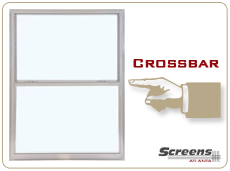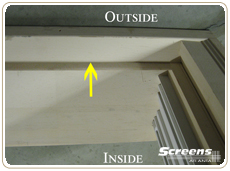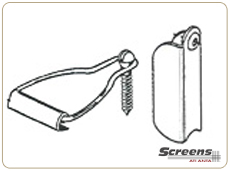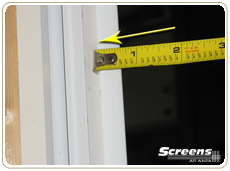MEASURE FOR DOUBLE HUNG SCREENS
As a reminder, if you have the current screen used for your window,
please use those “tip-to-tip” measurements as described earlier.
Double Hung Screens are much easier to order than Single Hung Screens.
There are really only 2 different types, can be installed with 2-3 different
hardware
combinations, and tend to come in more “standard sizes”.
Start from inside your house and lift the bottom portion of your window. Look at the bottom sill and along the sides to see if these areas are wood, or some other material (i.e. vinyl, aluminum, etc..).
Double Hung Window Screens should almost always use 7/16” screen frame, and use a “cross-bar” to stabilize its width.
WOOD WINDOW SCREENS:
If the sill area is wood, you have wood windows. You should notice towards the outer most portion of the sill where at lease both sides, and sometimes the top, has an “inset”, or “framed” looking area. These are called “stops”. They are designed to “stop” your screen from falling forward into your house. Your screen will actually rest against the “outside” of the “stops”, and it is here where you should take your measurements.
When measuring, keep in mind the purpose of the “stops”. As long as the
screen frame goes beyond the “stops” on all sides, your screen will stay in place. The wider the “stops”, the more margin of error you can have with
your measurement and still be ok.
place. The wider the “stops”, the more margin of error you can have with
your measurement and still be ok.
Widths are listed first, and Heights are listed second.
Using this guide, measure from inter-most portion of one “stop”, across to
the inter-most portion of the opposite side “stop”. Take this measurement at
the middle and bottom to ensure window frame is still square. Use the
“narrowest” measurement for your screen width and deduct 1/4”.

Use the guide to measure the height as well. Again, take 3 measurements (right, middle, and left.) Use the “shortest” measurement for your screen height and deduct 1/8”.
You will notice that the bottom “stop” is more like a short
“cut-out” in the frame.
DETERMINE HARDWARE
NEEDS FOR WOOD WINDOW SCREENS
If the inside portion of your sill is wood, you will need to order “Wood
Window Screens”. These screens will automatically come with “loop latches”
mounted on the screen. These latches will “loop” over a “bald-head screw”
(more like a big headed nail) that you will need to hammer into your sill at
the meeting place of loop latches. Additionally, you will be provided
“friction hangers” (aluminum channels) that you will need to mount to the
upper side of each sill, against the inside of the “stops”. The “friction
hangers” actually form a “track” that your screen frame will slide into. The
combination of the “bald-head screw” and “loop latches” will keep screen
frame in place.
If you are replacing an existing screen, your “bald-head screws” are probably already mounted to your sill. If that is the case, it will be unlikely that the new “friction hangers” will match the exact location of your current “bald-head screws”. If they do not, you will need to carefully remove the existing “bald-head screws” from your sill, and fill holes with a wood filler, and then mount the new “bald-head screws” in the correct spot.Widths are listed first, and Heights are listed second.
DOUBLE HUNG WINDOW SCREENS (NON-WOOD)
When lifting bottom portion of the window, look beyond the tracks where the top portion of the window travels up and down… you should see a “U-channel” on the top and bottom of the sill, with “L-channels” that run along the left and right side.
This is the area where your screen will rest.
Measure your width by taking the distance from the inside of one L-channel to the inside of the opposite L-channel. Take this measurement from the bottom portion of the sill and again around the middle of the window sill to ensure the
sill is square. Use the “narrowest” measurement and deduct 1/8” to determine your width.
When measuring your width, keep in mind that a good screen fit keeps the
outer portion of your screen frame beyond the L-channel on both sides.
Measure height by taking the distance from the inter most portion of the top
U-channel to the top ridge of the opposite U-channel. Take this measurement
along the right and left side to ensure the sill is square. Take the
shortest measurement and deduct 1/8”.
Take an additional deduction of 1/8” (total of 1/4”) if hardware is to be installed on the height. We recommend using “slip-on springs” on the top of the screen frames for this type of windows.
When measuring the height, keep in mind that during installation, you
will push the top portion of your screen into the upper U-channel, and then
the bottom portion of the screen frame will need to pass over the top ridge
of the bottom
U-channel before resting in place.

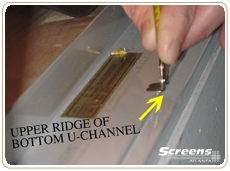
Measure height by taking the distance from the inter most portion of the top U-channel to the top ridge of the opposite U-channel.
DOUBLE HUNG WINDOW SCREENS (NON-wood) HARDWARE CHOICES
The easiest hardware method is to simply have “slip-on springs” added to the top of your screen frame, and “pull tabs” on the bottom. This will allow tension to be pushed downward from the top U-channel towards the bottom.
If you find a small groove that runs in the U-channel of the sides, or top of the sill, you can use “plungers” instead of “slip-on springs”. If the grooves are there and you decide to use “plungers”, you can only use plungers on sides, or top, where groove is located.
This “plunger” groove should be very narrow, and is not wide enough to accept your screen frame width. So, while measuring your U-channel, or L-channel, do not include your “plunger” groove, as it purpose is to accept the pin portion of the plunger, and has nothing to do with your screen frame measurement.
Remember to make additional deductions of 1/8” on any width/height that you use hardware with.
WARNING
All content on this website is protected by copyright © 2020 Screens
Atlanta. Please do not take any graphics or content from this site to use
for any other commercial endeavor without written permission from Screens
Atlanta. All violators will be prosecuted according to copyright laws.




